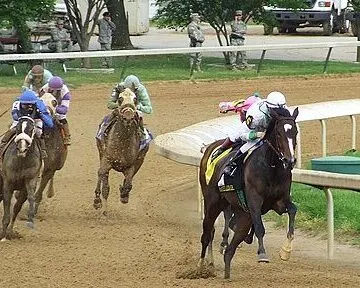Information about horse racing, from training techniques to racing equipment, is examined.
Welcome to the exciting world of claiming races! Where each horse can be bought, or “claimed,” by a registered buyer for a set price before the race begins. This opens opportunities for newcomers to join the racing community or for existing owners to expand their stables. Before you claim a horse, it’s crucial to examine …
Read More about How to Evaluate Horses in Claiming Races: Tips for Buyers
Explore the dynamic world of horse racing, where precision, strategy, and skill blend at breakneck speeds. As a seasoned racehorse owner with extensive experience working alongside jockeys, I’ve gained a deep understanding of the sport’s intricacies. One question that I’m frequently asked is why jockeys stand up during races. Drawing from my experience and comprehensive …
Read More about Why Jockeys Stand During Races: Riding Techniques Explained
Yesterday, I spent the entire day at the track, waiting for my horse to run in the last race. It’s pretty standard for me; whenever my horses race, I’m there from start to finish, betting on most of the races along the way. For me, it’s not just about the thrill; it’s about the strategy. …
Read More about Different Horse Racing Bets: A Quick Guide
When it comes to the thrill of the racetrack, it’s not just the muscles and the sleek coat that make a racehorse successful. Their mental traits are just as important. So, what makes a racehorse’s mind as strong as their physical ability? A successful racehorse typically shows a blend of high alertness, keen responsiveness, competitiveness, …
Read More about What Mental Traits Make a Successful Racehorse?
Thoroughbreds are considered the best racehorses due to their exceptional speed, agility, and strong competitive nature. Originating in the 17th century, they’ve become the face of horse racing, combining outstanding athletic abilities with a spirit unmatched in the equine world. This article explains the unique qualities that make the Thoroughbred breed unparalleled on the racetrack …
Read More about Why is the Thoroughbred Breed Preferred for Horse Racing?
In the high-stakes world of horse racing, the value of a champion extends far beyond the finish line. While the flashiest racehorses capture our hearts with their on-track heroics, it’s often their potential as sires that cements their legacy. Champion racehorse studs are the elite of the equine world, coveted for their superior genetics and …
Read More about The Legacy of Racehorse Studs: Champion Sires Explored
Horse racing, a thrilling test of speed and endurance, captivates millions globally. Yet, beneath the spectacle lies a world where horse racing safety and the spirit of fair competition are paramount. This delicate balance between competition and ethics forms the heart of the “Sport of Kings.” However, it’s not just about the rush of hooves …
Read More about Horse Racing Safety, Rules, and Integrity: Racing Right
Racehorses, known for their speed and agility, are also complex and emotional beings. This is why their psychological well-being is crucial; it directly influences their training and performance on the track. A racehorse’s mental state can be a key factor between a win and a lackluster performance. Recognizing this aspect is essential for anyone involved …
Read More about Horse Racing: Examining Behavior & Stress in Racehorses
Have you ever wondered what goes on race day in the exciting world of horse racing? Picture this: the sun is shining on the track, fans are cheering loudly, and the air is buzzing with anticipation. Each racehorse, is ready at the starting gate, but there’s so much that has happened before this moment and …
Read More about Race Day Rundown: A Deep Dive into Horse Racing Dynamics
Training horses for speed involves more than just speedwork; it’s about ensuring their well-being and happiness. Successful training combines coaching, medical care, and building a strong, supportive relationship with each horse. In this article, I’ll cover three essential parts of racehorse training. First, I’ll cover Basic Training – how young horses learn the basics of …
Read More about Training Horses For Speed: Basics to Advanced Techniques










